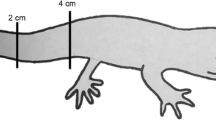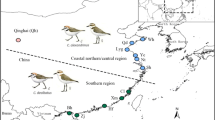Abstract
Nonlethal indices of contaminant exposure can facilitate research on the accumulation and effects of contaminants in wildlife. Here, we tested the efficacy of using amputated toes (“toe clips”), a common byproduct when marking amphibians in population and genetic studies, to determine mercury (Hg) concentrations in amphibians. We examined total mercury (THg) concentrations in American toads (Bufo americanus) collected along a contamination gradient at a Hg-contaminated field site. We found significant positive correlations between toe THg and blood THg concentrations in adult males and females collected in two different years. We also found that blood and toe clips could be used to predict maternal transfer of Hg, an important mechanism of reproductive toxicity in wildlife. Maternal toe THg concentrations were more highly correlated with egg THg concentrations than were maternal blood THg concentrations. Our results indicate that amputated toes are effective for identifying Hg concentrations in amphibians.


Similar content being viewed by others
References
Bank MS, Crocker J, Connery B, Amirbahman A (2007) Mercury bioaccumulation in green frog (Rana clamitans) and bullfrog (Rana catesbeiana) tadpoles from Acadia National Park, Maine, USA. Environ Toxicol Chem 26:118–125
Beaupre SJ, Jacobson ER, Lillywhite HB, Zamudio K (2004) Guidelines for the use of live amphibians and reptiles in field and laboratory research. A publication of the American Society of Ichthyologists and Herpetologists, approved by board of Governors, June 30, 2004, Norman, Oklahoma
Bergeron CM, Husak JF, Unrine JM, Romanek CS, Hopkins WA (2007) Influence of feeding ecology on blood mercury concentrations in four species of turtles. Environ Toxicol Chem 26:1733–1741
Bergeron CM, Bodinof CM, Unrine JM, Hopkins WA (2010a) Mercury accumulation along a contamination gradient and nondestructive indices of bioaccumulation in amphibians. Environ Toxicol Chem 29:980–988
Bergeron CM, Bodinof CM, Unrine JM, Hopkins WA (2010b) Bioaccumulation and maternal transfer of mercury and selenium in amphibians. Environ Toxicol Chem 29:989–997
Bergeron CM, Hopkins WA, Todd BD, Hepner MJ, Unrine JM (2011) Interactive effects of maternal and dietary mercury exposure have latent and lethal consequences for amphibian larvae. Environ Sci Technol 45:3781–3787
Biek R, Funk WC, Maxell BA, Mills LS (2002) What is missing in amphibian decline research: insights from ecological sensitivity analysis. Conserv Biol 16:728–734
Burton TM, Likens GE (1975) Salamander populations and biomass in the Hubbard Brook Experimental Forest, New Hampshire. Copeia 1975:541–546
Carter LJ (1977) Chemical plants leave unexpected legacy for two Virginia rivers. Science 198:1015–1020
Crump KL, Trudeau VL (2009) Mercury-induced reproductive impairment in fish. Environ Toxicol Chem 28:895–907
Day RD, Christopher SJ, Becker PR, Whitaker DW (2005) Monitoring mercury in the loggerhead sea turtle, Caretta caretta. Environ Sci Technol 39:437–446
Eisler R (2006) Mercury hazards to living organisms. CRC Press, Boca Raton
Fitzgerald WF, Engstrom DR, Mason RP, Nater EA (1998) The case for atmospheric mercury contamination in remote areas. Environ Sci Technol 32:1–7
Fletcher DE, Hopkins WA, Saldaña T, Baionno JA, Arribas C, Standora MM, Fernández-Delgado C (2006) Geckos as indicators of mining pollution. Environ Toxicol Chem 25:2432–2445
Heyer WR, Donnelly MA, McDiarmid RW, Hayek LAC, Foster MS (1994) Measuring and monitoring biological diversity: standard methods for amphibians. Smithsonian Institution Press, Washington
Hopkins WA (2007) Amphibians as models for studying environmental change. ILAR J 48:270–277
Hopkins WA, Mendonça MT, Rowe CL, Congdon JD (1998) Elevated trace element concentrations in Southern toads, Bufo terrestris, exposed to coal combustion waste. Arch Environ Contam Toxicol 35:325–329
Hopkins WA, Roe JH, Snodgrass JW, Jackson BP, Kling DE, Rowe CL, Congdon JD (2001) Nondestructive indices of trace element exposure in squamate reptiles. Environ Pollut 115:1–7
Hopkins WA, Snodgrass JW, Baionno JA, Roe JH, Staub BP, Jackson BP (2005) Functional relationships among selenium concentrations in the diet, target tissues, and nondestructive tissue samples of two species of snakes. Environ Toxicol Chem 24:344–351
Hothem RL, Jennings MR, Crayon JJ (2010) Mercury contamination in three species of anuran amphibians from the Cache Creek Watershed, California, USA. Environ Monit Assess 163:433–448
Jackson BP, Hopkins WA, Baionno J (2003) Laser ablation-ICP-MS analysis of dissected tissue: a conservation-minded approach to assessing contaminant exposure. Environ Sci Technol 37:2511–2515
Kalb HJ, Zug GR (1990) Age estimates for a population of American Toads, Bufo americanus (Salientia: Bufonidae), in Northern Virginia. Brimleyana 16:79–86
Linder G, Grillitsch B (2000) Ecotoxicology of metals. In: Sparling DW, Linder G, Bishop CA (eds) Ecotoxicology of amphibians and reptiles. SETAC Press, Pensacola, pp 325–459
Linder G, Krest SK, Sparling DW (2003) Amphibian decline: an integrated analysis of multiple stressor effects. SETAC Press, Pensacola
Liner AE, Smith LL, Castleberry SB (2007) Effects of toe-clipping on the survival and growth of Hyla squirella. Herpetol Rev 38:143–145
Malvandi H, Ghasempouri S, Esmaili-Sari A, Bahramifar N (2010) Evaluation of the suitability of application of golden jackal (Canis aureus) hair as a noninvasive technique for determination of body burden mercury. Ecotoxicology 19:997–1002
McCarthy MA, Parris KM (2004) Clarifying the effect of toe clipping on frogs with Bayesian statistics. J Appl Ecol 41:780–786
Phillott AD, Skerratt LF, McDonald KR, Lemckert FL, Hines HB, Clarke JM, Alford RA, Speare R (2007) Toe-clipping as an acceptable method of identifying individual anurans in mark recapture studies. Herpetol Rev 38:305–308
Pough FH (1980) The advantages of ectothermy for tetrapods. Am Nat 115:92–112
Regester KJ, Lips KR, Whiles MR (2006) Energy flow and subsidies associated with the complex life cycle of ambystomatid salamanders in ponds and adjacent forest in southern Illinois. Oecologia 147:303–314
Rudd JWM (1995) Sources of methyl mercury to freshwater ecosystems: a review. Water Air Soil Pollut 80:697–713
Scheuhammer AM, Meyer MW, Sandheinrich MB, Murray MW (2007) Effects of environmental methylmercury on the health of wild birds, mammals, and fish. Ambio 36:12–18
Schmidt BR, Feldmann R, Schaub M (2005) Demographic processes underlying population growth and decline in Salamandra salamandra. Conserv Biol 19:1149–1156
Sparling DW, Linder G, Bishop CA, Krest SK (eds) (2010) Ecotoxicology of amphibians and reptiles, 2nd edn. CRC Press, Boca Raton, FL
Tan SW, Meiller JC, Mahaffey KR (2009) The endocrine effects of mercury in humans and wildlife. Crit Rev Toxicol 39:228–269
Todd BD, Bergeron CM, Hepner MJ, Burke JN, Hopkins WA (2011a) Does maternal exposure to an environmental stressor affect offspring response to predators? Oecologia 166:283–290
Todd BD, Bergeron CM, Hepner MJ, Hopkins WA (2011b) Aquatic and terrestrial stressors in amphibians: a test of the double jeopardy hypothesis based on maternally and trophically derived contaminants. Environ Toxicol Chem 30:2277–2284
Unrine JM, Hopkins WA, Romanek CS, Jackson BP (2007) Bioaccumulation of trace elements in omnivorous amphibian larvae: implications for amphibian health and contaminant transport. Environ Pollut 149:182–192
Wada H, Yates DE, Evers DC, Taylor RJ, Hopkins WA (2010) Tissue mercury concentrations and adrenocortical responses of female big brown bats (Eptesicus fuscus) near a contaminated river. Ecotoxicology 19:1277–1284
Waddle JH, Rice KG, Mazzotti FJ, Percival HF (2008) Modeling the effect of toe clipping on treefrog survival: beyond the return rate. J Herpetol 42:467–473
Weiner JG, Spry DJ (1996) Toxicological significance of mercury in freshwater fish. In: Beyer WN, Heinz GH, Redmon-Norwood AW (eds) Environmental contaminants in wildlife: interpreting tissue concentrations. lewis, Boca Raton, pp 297–340
Wolfe MF, Schwarzbach S, Sulaiman RA (1998) Effects of mercury on wildlife: a comprehensive review. Environ Toxicol Chem 17:146–160
Acknowledgments
We thank S. Budischak, D. Cristol, K. Carlson-Drexler, A. Condon, M. Hepner, M. Howie, C. Ramos, J. Schmerfeld, H. Wada, and the South River Science Team for assistance and project support. We thank the landowners long the South River and the Waynesboro Parks and Recreation Department for access to sampling locations. Financial support was provided by E. I. DuPont de Nemours, Virginia Tech, and by the National Science Foundation (NSF # IOB-0615361). CMB was supported by the U.S. EPA STAR Graduate Fellowship (FP-9170040-1). EPA has not officially endorsed this publication and the views expressed herein may not reflect the views of the EPA. Research was completed with oversight from the South River Science Team, which is a collaboration of state and federal agencies, academic institutions, and environmental interests. Collecting permits and IACUC permission were obtained through WAH at Virginia Polytechnic Institute and State University.
Author information
Authors and Affiliations
Corresponding author
Rights and permissions
About this article
Cite this article
Todd, B.D., Bergeron, C.M. & Hopkins, W.A. Use of toe clips as a nonlethal index of mercury accumulation and maternal transfer in amphibians. Ecotoxicology 21, 882–887 (2012). https://doi.org/10.1007/s10646-012-0850-2
Accepted:
Published:
Issue Date:
DOI: https://doi.org/10.1007/s10646-012-0850-2




